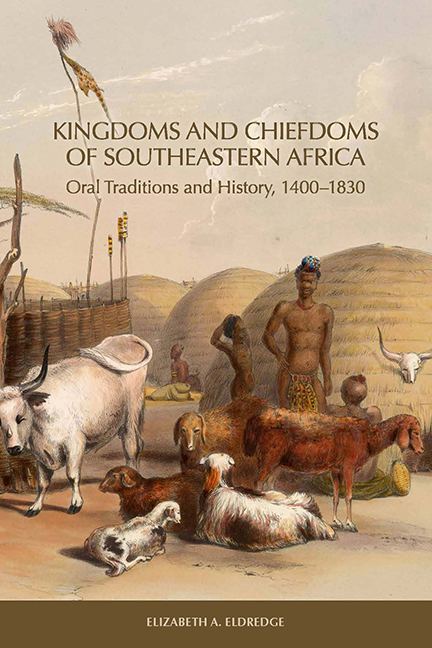Book contents
- Frontmatter
- Contents
- List of Illustrations
- Preface
- 1 History and Oral Traditions in Southeastern Africa
- 2 Oral Traditions in the Reconstruction of Southern African History
- 3 Shipwreck Survivor Accounts from the Sixteenth and Seventeenth Centuries
- 4 Founding Families and Chiefdoms East of the Drakensberg
- 5 Maputo Bay Peoples and Chiefdoms before 1740
- 6 Maputo Bay, 1740–1820
- 7 Eastern Chiefdoms of Southern Africa, 1740–1815
- 8 Zulu Conquests and the Consolidation of Power, 1815–21
- 9 Military Campaigns, Migrations, and Political Reconfiguration
- 10 Ancestors, Descent Lines, and Chiefdoms West of the Drakensberg before 1820
- 11 The Caledon River Valley and the BaSotho of Moshoeshoe, 1821–33
- 12 The Expansion of the European Presence at Maputo Bay, 1821–33
- 13 Southern African Kingdoms on the Eve of Colonization
- Appendix A Ama Swazi King Lists
- Appendix B Chronology of Conflicts, Migrations, and Political Reconfiguration East of the Drakensberg in the Era of Shaka
- Appendix C Interviewees from the James Stuart Collection of Oral Traditions
- Notes
- Bibliography
- Index
Appendix B - Chronology of Conflicts, Migrations, and Political Reconfiguration East of the Drakensberg in the Era of Shaka
Published online by Cambridge University Press: 14 March 2018
- Frontmatter
- Contents
- List of Illustrations
- Preface
- 1 History and Oral Traditions in Southeastern Africa
- 2 Oral Traditions in the Reconstruction of Southern African History
- 3 Shipwreck Survivor Accounts from the Sixteenth and Seventeenth Centuries
- 4 Founding Families and Chiefdoms East of the Drakensberg
- 5 Maputo Bay Peoples and Chiefdoms before 1740
- 6 Maputo Bay, 1740–1820
- 7 Eastern Chiefdoms of Southern Africa, 1740–1815
- 8 Zulu Conquests and the Consolidation of Power, 1815–21
- 9 Military Campaigns, Migrations, and Political Reconfiguration
- 10 Ancestors, Descent Lines, and Chiefdoms West of the Drakensberg before 1820
- 11 The Caledon River Valley and the BaSotho of Moshoeshoe, 1821–33
- 12 The Expansion of the European Presence at Maputo Bay, 1821–33
- 13 Southern African Kingdoms on the Eve of Colonization
- Appendix A Ama Swazi King Lists
- Appendix B Chronology of Conflicts, Migrations, and Political Reconfiguration East of the Drakensberg in the Era of Shaka
- Appendix C Interviewees from the James Stuart Collection of Oral Traditions
- Notes
- Bibliography
- Index
Summary
1750 – 60
Two large chiefdoms, the AmaThuli and the AmaCele, migrated from north to south of the Thukela River.
1750 – 1800
North of the Thukela River several major chiefdoms consolidated control over territory and expanding populations. These chiefdom and their chiefs in 1800 were Ama Hlubi (Chief Bungane), Swazi (Chief Ndvungunye son of Ngwane), AmaNdwandwe (Chief Zwide), AmaMthethwa (Chief Dingiswayo), and AbaQwabe (Chief Kondhlo).
The proto-Swazi Chief Ngwane led his chiefdom south from the Lebombo Mountains to the Magudu hills area just south of modern Swaziland, where over time they came into confLict with the AmaNdwandwe there, with whom they were distantly related.
Smaller chiefdoms ranging in size from several households of fewer than one hundred people under the senior male of the line of descent to one or two thousand people ruled by the senior male of the dominant line also proliferated, and over time their chiefs became tributary subordinates to the more powerful chiefs. The AmaZulu chiefdom under Chief Senzangakhona became tributary to the AmaMthethwa of Chief Dingiswayo but also incorporated several smaller chiefdoms under AmaZulu rule. Their neighbors the eLangeni (AmaLanga) under Chief Mbengi and then his son Mgabi were on friendly terms, and in the 1780s Mbengi's daughter Nandi bore Senzangakhona's first son out of wedlock, Shaka (pronounced Tshaka or Chaka), who was raised mostly by his maternal relatives with his first cousin Makedama.
∼1805
Makedama violently seized the eLangeni chieftaincy, causing other members of the ruling family, with Shaka, to migrate and seek refuge with Chief Dingiswayo of the AmaMthethwa. Shaka served in Dingiswayo's army circa 1806 – 16, during which time the AmaMthethwa fought battles against at least eight chiefdoms.
1815
Swazi Chief Ndvungunye died and was succeeded by Somhlolo, later called Sobhuza, who consolidated rule over the smaller chiefdoms of modern Swaziland (Nguni and SeSotho cultural heritage), 1816 – 20.
1816
AmaZulu chief Senzangakhona died; Shaka returned and usurped the Ama- Zulu chieftaincy, ordering the half brother who was the heir to be killed.
1816 – 17
AmaZulu impis were sent against small nearby chiefdoms (at least nine), which were subordinated and incorporated by diplomacy (e.g., Chief Pungatshe of the AmaButhelezi) or by force.
- Type
- Chapter
- Information
- Kingdoms and Chiefdoms of Southeastern AfricaOral Traditions and History, 1400–1830, pp. 333 - 338Publisher: Boydell & BrewerPrint publication year: 2015

